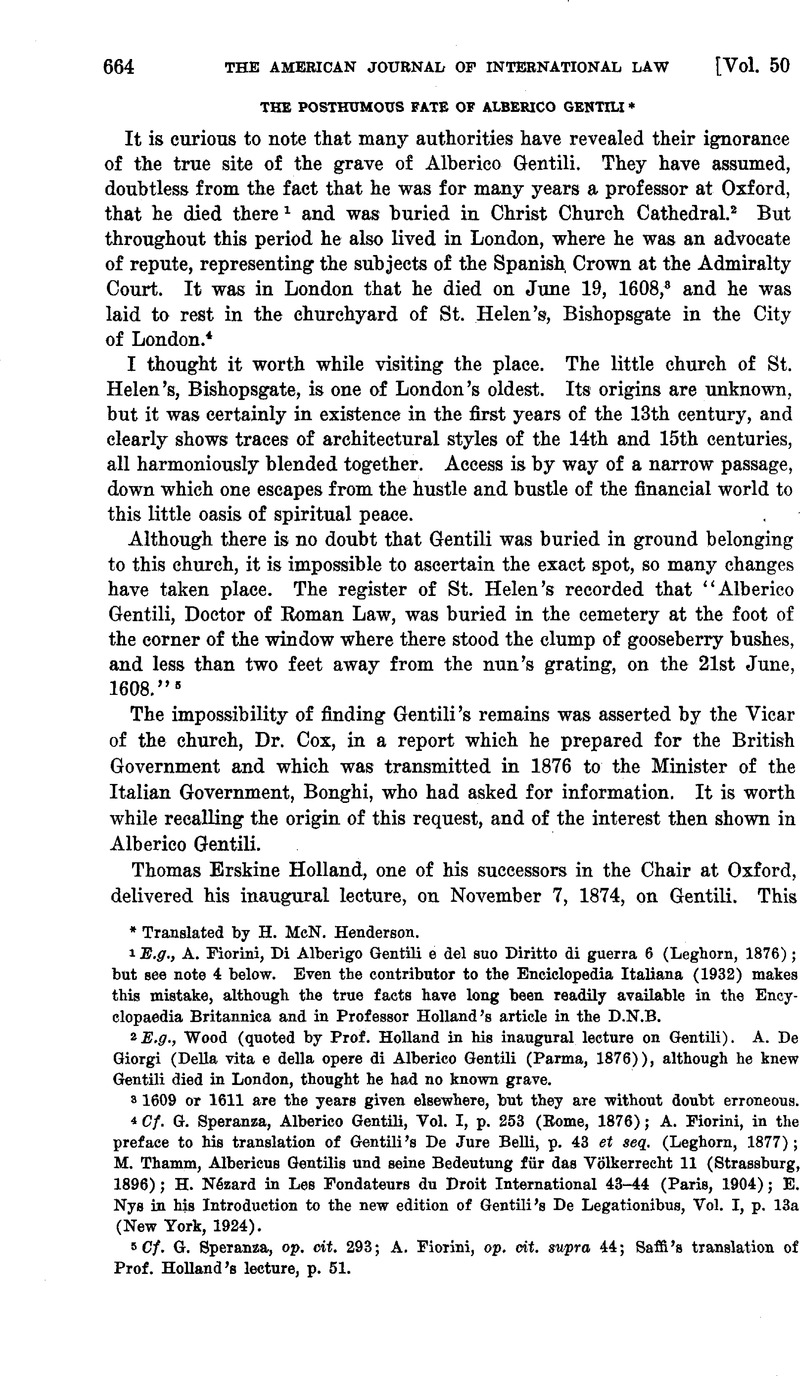No CrossRef data available.
Article contents
The Posthumous Fate of Alberico Gentili*
Published online by Cambridge University Press: 28 March 2017
Abstract

- Type
- Notes and Comments
- Information
- Copyright
- Copyright © American Society of International Law 1956
Footnotes
Translated by H. McN.Henderson.
References
1 E.g., Fiorini, A., Di Alberigo Gentili e del suo Diritto di guerra 6 (Leghorn, 1876)Google Scholar; but see note 4 below. Even the contributor to the Enciclopedia Italiana (1932) makes this mistake, although the true facts have long been readily available in the Encyclopaedia Britannica and in Professor Holland’s article in the D.N.B.
2 E.g., Wood (quoted by Prof. Holland in his inaugural lecture on Gentili). De Giorgi, A. (Delia vita e della opere di Alberieo Gentili (Parma, 1876))Google Scholar, although he knew Gentili died in London, thought he had no known grave.
3 1609 or 1611 are the years given elsewhere, but they are without doubt erroneous.
4 Cf. G. Speranza, Alberieo Gentili, Vol. I, p. 253 (Rome, 1876); A. Fiorini, in the preface to his translation of Gentili’s De Jure Belli, p. 43 et seq. (Leghorn, 1877); Thamm, M., Albericus Gentilis und seine Bedeutung für das Völkerrecht 11 (Strassburg, 1896)Google Scholar; Nézard, H. in Les Fondateurs du Droit International 43–44 (Paris, 1904)Google Scholar; E. Nys in his Introduction to the new edition of Gentili’s De Legationibus, Vol. I, p. 13a (New York, 1924).
5 Cf. G. Speranza, op. cit. 293; A. Fiorini, op. cit. supra 44; Saffi’s translation of Prof. Holland’s lecture, p. 51.
6 Often 1551 is given as the year of his birth, but the 1552 is taken from a note by Gentili in his own handwriting, quoted by Saffi in the Appendix to his translation of Prof. T. E. Holland’s lecture, p. 46 (Rome, 1884). The year 1551, however, appears to be confirmed by the text of the memorial inscription “Aetatis LVIII.”
7 It was proposed to transport them, had it been possible, to the church of Santa Croce (in Florence, of course, and not in Rome as written by Nézard, in Les fondateurs du Droit International 44, cited in note 4 above).
8 Among similar verdicts on Gentili, we recall, for instance, that of Coleman Phillipson, who in his introduction to the new edition of Belli, De Jure, published by the Carnegie Endowment for International Peace (Classics of International Law, Oxford, 1933)Google Scholar, writes: “Because of the greater affinity between his point of view and that of modern States and jurists, he [Gentili] is, in that respect, as much as, if not more than, Grotius, the progenitor of the existing law of nations.” (Vol. II, pp. 11a–12a, cf. p. 18a, where the verdicts of Ompteda, Lampredi, etc., are also reported; cf. also the notices gathered by Speranza, op. cit., Vol. I, p. 259 et seq.)




